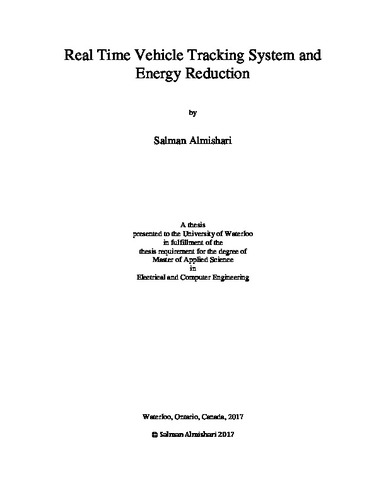| dc.contributor.author | Almashari, Salman | |
| dc.date.accessioned | 2017-08-29 15:45:56 (GMT) | |
| dc.date.available | 2018-08-30 04:50:06 (GMT) | |
| dc.date.issued | 2017-08-29 | |
| dc.date.submitted | 2017-08-22 | |
| dc.identifier.uri | http://hdl.handle.net/10012/12260 | |
| dc.description.abstract | Technology has been growing rapidly and various fields of technology can be combined to advance societies. The Internet of Things (IoT) is one of these technologies that combines and connects a variety of things to come up with some more beneficial information. In this thesis, an example of an IoT portable system has been built and tested.
The system is called Smart Vehicle System (SVS), and includes three main parts: the Tracking Unit, Cloud, and Android application. The Tracking Unit is positioned inside a vehicle to sense the vehicle’s temperature, speed, and location, then uploads them to the cloud via GSM network. All the components and communication of this Tracking Unit are described in detail. The cloud includes a web panel to view and manage the data, web server to do data processing, and database to store all the information. The Android application is used to receive notifications and to view the vehicle’s current temperature and location.
Some constraints are included in the system to notify the administrator and the driver of certain events. The emphasis is on two main constraints: high or low temperatures inside the vehicle and location restrictions. The administrator sets up these constraints using the web panel. If there is any violation of these constraints, notifications are issued and sent to the administrator via email and to the Android application. The processes of these constraints are described in detail. This system is intended to help transportation companies manage their fleets more effectively.
The SVS is a portable system, and so it functions on batteries. Therefore, a power reduction algorithm is recommended and examined. We have performed 19 different experiments, before and after applying the proposed algorithm; four of them are dynamic and 15 are at a fixed location. With the power reduction algorithm, we are able to reduce the energy consumption of the tracking unit up to 17%. All the setup and results are presented. A Monsoon Power Monitor device and a laptop are used to measure the power consumption and compare the results. We conclude that there is a need for data processing before uploading results to the cloud, which saves power and database size. | en |
| dc.language.iso | en | en |
| dc.publisher | University of Waterloo | en |
| dc.subject | IoT | en |
| dc.subject | Tracking | en |
| dc.subject | Vehicle | en |
| dc.subject | GPS | en |
| dc.subject | GPRS | en |
| dc.subject | System | en |
| dc.subject | Cloud | en |
| dc.subject | Power | en |
| dc.subject | SIM908 | en |
| dc.subject | Arduino | en |
| dc.subject | Temperature | en |
| dc.subject | Android Application | en |
| dc.subject | GSM | en |
| dc.subject | Monsoon | en |
| dc.title | Real Time Vehicle Tracking System and Energy Reduction | en |
| dc.type | Master Thesis | en |
| dc.pending | false | |
| uws-etd.degree.department | Electrical and Computer Engineering | en |
| uws-etd.degree.discipline | Electrical and Computer Engineering | en |
| uws-etd.degree.grantor | University of Waterloo | en |
| uws-etd.degree | Master of Applied Science | en |
| uws-etd.embargo.terms | 1 year | en |
| uws.contributor.advisor | Naik, Kshirasagar | |
| uws.contributor.affiliation1 | Faculty of Applied Health Sciences | en |
| uws.published.city | Waterloo | en |
| uws.published.country | Canada | en |
| uws.published.province | Ontario | en |
| uws.typeOfResource | Text | en |
| uws.peerReviewStatus | Unreviewed | en |
| uws.scholarLevel | Graduate | en |

